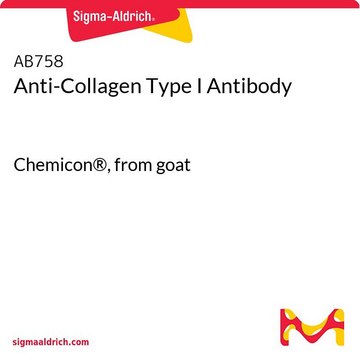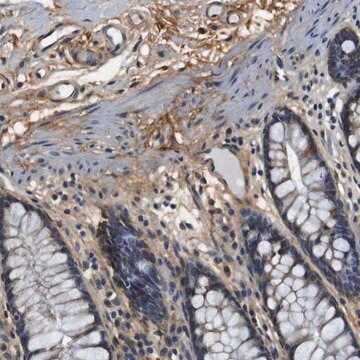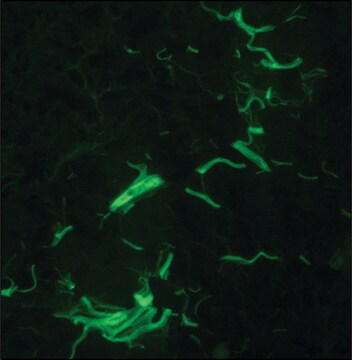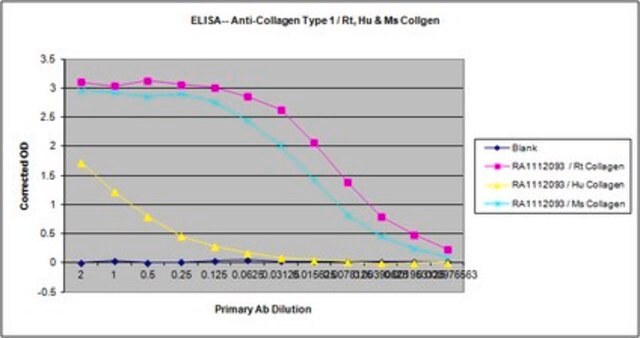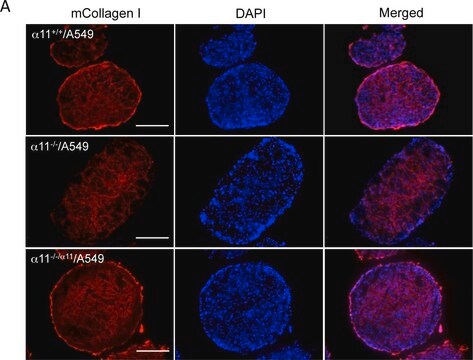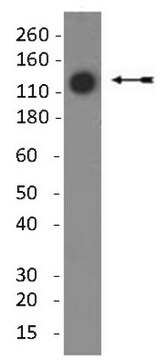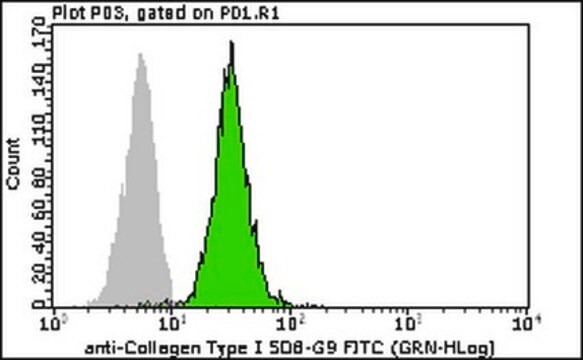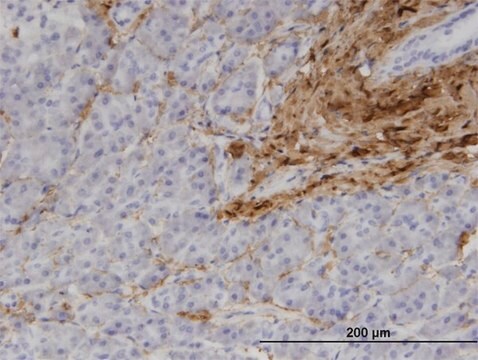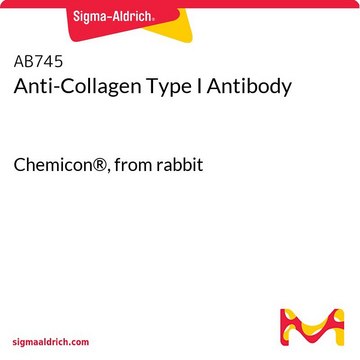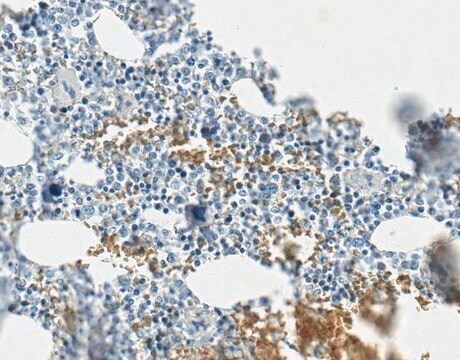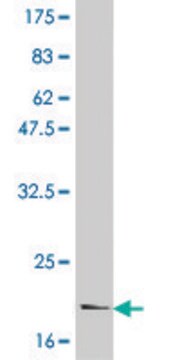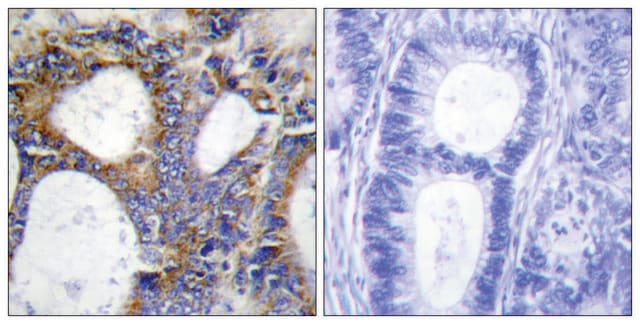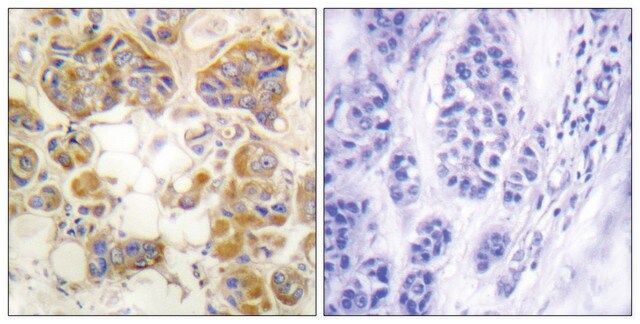MAB3391
Anti-Collagen Type I Antibody, clone 5D8-G9
clone 5D8-G9, Chemicon®, from mouse
Synonim(y):
Anti-CAFYD, Anti-EDSARTH1, Anti-EDSC, Anti-OI1, Anti-OI2, Anti-OI3, Anti-OI4
About This Item
Polecane produkty
pochodzenie biologiczne
mouse
Poziom jakości
forma przeciwciała
purified immunoglobulin
rodzaj przeciwciała
primary antibodies
klon
5D8-G9, monoclonal
reaktywność gatunkowa
pig, canine, sheep, human, bovine
spodziewany brak reakcji z
guinea pig, ground squirrel, rat, kangaroo, horse, chicken, mouse
producent / nazwa handlowa
Chemicon®
metody
ELISA: suitable
flow cytometry: suitable
immunohistochemistry: suitable
western blot: suitable
izotyp
IgG1
numer dostępu NCBI
numer dostępu UniProt
Warunki transportu
wet ice
docelowa modyfikacja potranslacyjna
unmodified
informacje o genach
human ... COL1A1(1277)
Powiązane kategorie
Opis ogólny
Specyficzność
Collagen Type I Antibody displays a high affinity for human, bovine and ovine Type I Collagens. There is no evidence for cross reactivity with Collagen Types III, V and VI or connective tissue protein. Antibody reacts only with native, non-denatured Collagen I
Zastosowanie
Immunohistochemistry:unfixed frozen sections:
Cut 6 μm thick sections from frozen samples using a freezing microtome. Air-dry throughly. Rehydrate with PBS. Blocking is usually not necessary for IF studies, if using DAB, pretreatment for peroxidase is suggested and blocking 2% BSA in PBS will reduce back ground.
Dilute Collagen Type I Antibody in PBS buffer, add to the sample(s) and incubate for 60 minutes. (1:100-1:500).
Wash sections for 10 minutes in PBS, twice. Add FITC conjugated anti-mouse antibody and incubate for 60 minutes.
Wash for 10 minutes in PBS, twice.
Mount sections in glycerol/water (9:1 v/v) containing 1 mM 1,4-phenylenediamine. (for FITC stability or use Chemicon catalog numbers 5096 or 5013.
NOTE:
Preliminary studies suggest that enhanced staining of certain tissues maybe obtained by pretreatment (previous to step 2) of sections with various enzymes (eg 0.1% pepsin in 0.1M HCl, 37°C for 5 minutes).
Flow Cytometry: 1:100
Immunoblotting:1:1000 using NATIVE, non-denatured, non-reduced western blots only. Ramshaw, et.al (1988) "Electrophoretic and electroblotting of native collagens." Anal. Biochem. 168:82-87. Antibody will not work in traditional, reduced western blots.
Briefly, PAGE gels must be prepared for running native collagens.
A 3% (w/v) total acrylamide separating gel, containing 3.2% (w/w) bis-acrylamide as a proportion to a monomer as the crosslinking agent, in 10mM calcium lactate, pH 6.8 is polymerized between vertical glass plates by the addition of 0.05-0.1% TEMED and 0.05-.1% ammonium persulfate (added from a 10% stock solution). The cathode buffer (negative) buffer is 50mM Tris adjusted to pH 6.6 with lactic acid; the anode (positive) buffer is 0.1M lactic acid pH 2.5 {Friis, SJ et al, 1985 J Biochem Biophys Methods 10:301-306.}.
Prior to sample loading the gel is run for at least 90 minutes at 100V. Collagen samples are dissolved at 1mg/mL in either 0.1M lactic acid or 0.1M acetic acid containing 10% sucrose, and 5-10μg per lane is loaded. Methyl green is added as required to assist loading. Electrophoresis is 70V for 5 hours, room temperature.
Blotting uses 0.1M lactic acid pH 2.5, and 20V for 16 hours at room temperature with the collagens migrating toward the cathode.
Cell Structure
ECM Proteins
Postać fizyczna
The immunoglobulin fraction has been purified by Protein A Chromatography and shown to be >95% pure by coomassie PAGE. The Collagen Type I Antibody is supplied 0.22 micron filtered.
Przechowywanie i stabilność
WARNING: The monoclonal reagent solution contains 0.1% sodium azide as a preservative. Due to potential hazards arising from the build up of this material in pipes, spent reagent should be disposed of with liberal volumes of water.
Komentarz do analizy
Human kidney lysate
Informacje prawne
Oświadczenie o zrzeczeniu się odpowiedzialności
Nie możesz znaleźć właściwego produktu?
Wypróbuj nasz Narzędzie selektora produktów.
Kod klasy składowania
12 - Non Combustible Liquids
Klasa zagrożenia wodnego (WGK)
WGK 2
Temperatura zapłonu (°F)
Not applicable
Temperatura zapłonu (°C)
Not applicable
Certyfikaty analizy (CoA)
Poszukaj Certyfikaty analizy (CoA), wpisując numer partii/serii produktów. Numery serii i partii można znaleźć na etykiecie produktu po słowach „seria” lub „partia”.
Masz już ten produkt?
Dokumenty związane z niedawno zakupionymi produktami zostały zamieszczone w Bibliotece dokumentów.
Klienci oglądali również te produkty
Nasz zespół naukowców ma doświadczenie we wszystkich obszarach badań, w tym w naukach przyrodniczych, materiałoznawstwie, syntezie chemicznej, chromatografii, analityce i wielu innych dziedzinach.
Skontaktuj się z zespołem ds. pomocy technicznej